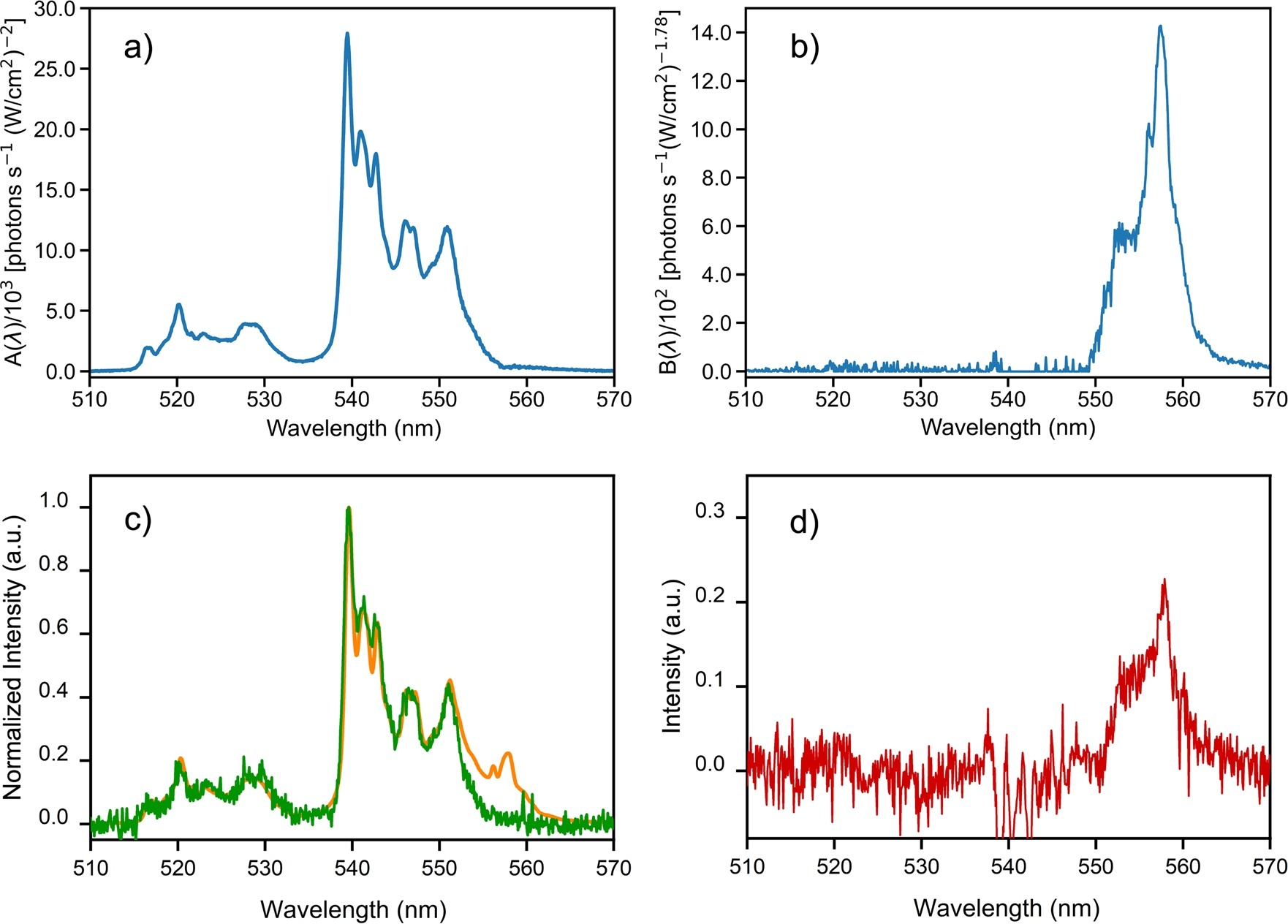Method for separating spectrally overlapping multiphoton upconverted emission bands through spectral power dependence analysis
The high quantum efficiency and long lifetimes of upconverting rare-earth-doped systems make luminescence band spectral overlap a particularly common phenomenon, frequently associated with various excitation and relaxation pathways. While it is often considered challenging to experimentally distinguish such overlapping luminescent bands, herein it is proposed a new method based on the different spectral responses of those luminescent lines to the excitation power at a single pumping wavelength laser. A model for the population of the overlapping bands in terms of the pump laser power is considered and fitted for each measured wavelength, resulting in separated spectra for each pathway. The results obtained with the proposed method are considered with direct excitation measurements, showing the effectiveness and simplicity of the method in comparison with more traditional approaches.
Journal of Luminescence 257, 119685 (2023).
Observation and analysis of nonlinear scattering using the scattered-light imaging method
Optical phenomena like nonlinear absorption and nonlinear refraction are often determined through light transmittance techniques. However, in turbid or resonant media, scattering may also significantly attenuate the laser beam, such that absorptive losses may be overestimated. Thus, while transmittance techniques are suitable to determine the power extinction, it is often difficult to characterize the contribution of nonlinear scattering in a sample. In this work we applied the scattered-light imaging method to discriminate the nonlinear extinction due to nonlinear absorption and nonlinear scattering contributions in a turbid medium constituted of TiO2 nanoparticles suspended in acetone. The single-shot method collects an image of the beam transverse profile evolution along the propagation axis inside the sample. It was observed that while the results obtained by the transmittance technique indicate the extinction coefficient (including scattering and absorption contributions), the results obtained with the scattered-light imaging method discriminate the contribution of each phenomenon. Therefore, the results of both approaches are complementary and allow a more complete characterization of turbid media.
Physical Review A 105, (2022).
2D Thermal Maps Using Hyperspectral Scanning of Single Upconverting Microcrystals: Experimental Artifacts and Image Processing
Whereas lanthanide-based upconverting particles are promising candidates for several micro- and nanothermometry applications, understanding spatially varying effects related to their internal dynamics and interactions with the environment near the surface remains challenging. To separate the bulk from the surface response, this work proposes and performs hyperspectral sample-scanning experiments to obtain spatially resolved thermometric measurements on single microparticles of NaYF4: Yb3+,Er3+. Our results showed that the particle's thermometric response depends on the excitation laser incidence position, which may directly affect the temperature readout. Furthermore, it was noticed that even minor temperature changes (<1 K) caused by room temperature variations at the spectrometer CCD sensor used to record the luminescence signal may significantly modify the measurements. This work also provides some suggestions for building 2D thermal maps that shall be helpful for understanding surface-related effects in micro- and nanothermometers using hyperspectral techniques. Therefore, the results presented herein may impact applications of lanthanide-based nanothermometers, as in the understanding of energy-transfer processes inside systems such as nanoelectronic devices or living cells.
ACS Applied Materials &$\mathsemicolon$ Interfaces 14, 38311--38319 (2022).
Second harmonic scattering of redox exfoliated two-dimensional transition metal dichalcogenides
We report the second harmonic scattering experiments from acetonitrile liquid suspensions of two-dimensional metal dichalcogenide nanoflakes,: the semiconducting MoS2 and WS2, the metallic NbS2, and the semi-metallic ZrTe2. Because the study is directly performed in the liquid phase, no symmetry breaking can be attributed to a supporting substrate as it is often the case in the investigation of the second harmonic generation efficiency for these materials. A comparative look of the origin of the nonlinear response using polarization analysis of the hyper Rayleigh scattering intensity is performed. Retardation is clearly exhibited by all nanoflakes considering their average dimensions but remains weak. This is attributed to the non-negligible role played by the nanoflake edges or the presence of surface absorbed polyoxometalates (POMs), in all cases.
Optical Materials 133, 112780 (2022).



